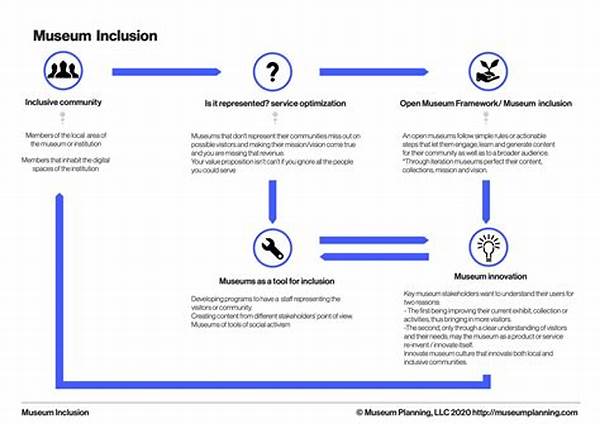The sun peeked through the clouds on a crisp Saturday morning, ideal for an adventure. Sarah was not just planning any day out; she was crafting an experience, a guided journey through time. With a steaming cup of coffee beside her, she pulled out the crinkled map of her city’s museums and traced her finger along the places she longed to explore. Today wasn’t just any visit; it was a mission steeped in strategic museum visit planning, aimed at immersing herself in art and history like never before.
Read Now : Strengthening Local Arts Ecosystems
Understanding the Art of Museum Visit Planning
Sarah knew that visiting a museum was not merely about wandering its halls but about diving deep into its stories. She recalled how important it was to begin strategic museum visit planning days before the actual visit. It started with researching the museums, understanding the exhibits, and checking visiting hours to avoid crowds. Sarah often felt that the heart of strategic museum visit planning was about making choices; deciding which exhibits to see, which tours to take, and even which cafes to rest in and reflect amidst masterpieces.
Knowing the museum layout was essential, much like a general studying the battlefield. Sarah envisioned herself as an explorer, charting unknown territories. By engaging in strategic museum visit planning, she could prioritize key exhibits and allocate ample time to soak in each artwork or artifact. Her goal was to experience the stories behind each creation, crafting a narrative from the past that intertwined with her own personal journey. With her plan in place, Sarah felt empowered and ready to embark on her cultural expedition.
Essential Steps in Strategic Museum Visit Planning
1. Research the Exhibits: Knowing what’s on display helps focus your interests. Strategic museum visit planning begins with exploring current and upcoming exhibitions.
2. Timing is Everything: Visit during off-peak hours. Strategic museum visit planning involves choosing the right time to avoid crowds and have a more intimate experience.
3. Map Your Route: Familiarize yourself with the museum’s layout. In strategic museum visit planning, knowing where to go saves time and energy.
4. Prioritize Highlights: Identify must-see pieces. Strategic museum visit planning helps in zeroing in on significant artworks or artifacts.
5. Plan for Breaks: Museums can be overwhelming. Incorporate rest spots into your strategic museum visit planning to recharge and reflect.
The Emotional Journey of a Museum Visit
As Sarah stepped into the grand hall, the echoes of history enveloped her like a warm embrace. The strategic museum visit planning she had devoted her morning to allowed her to glide seamlessly through the exhibits, each corner unraveling new tales. She marveled at ancient relics, each piece whispering secrets of a time long past. Her careful planning meant she wasn’t rushed; she lingered over brush strokes and marveled at sculptor’s tools.
While standing before a monumental painting, Sarah pondered the artist’s thoughts and emotions, how strategic museum visit planning had brought her face-to-face with the essence of human creativity. Her journey through the corridors became more than an exploration; it was a dialogue with souls across time. The art spoke, resonating deeply, leaving her inspired and introspective. Here, in the midst of creativity collected over centuries, Sarah realized the power of her strategic museum visit planning, transforming ordinary sightseeing into a personal odyssey.
The Story Behind Every Artifact
A well-executed visit meant uncovering stories behind each artifact. In her research, Sarah discovered the craftsman’s tale behind a seemingly simple vase. The strategic museum visit planning she engaged in meant that, standing before it, she could fully appreciate its intricate designs and the culture it represented.
Read Now : Advanced Pigment Blending Techniques
Through her planning, Sarah understood the narrative flow of the exhibitions. She began with prehistoric relics and advanced through eras, each gallery connecting seamlessly to the next. Her strategic museum visit planning had crafted a narrative, guiding her through the evolution of human expression.
The strategic museum visit planning paid off during a guided tour. Hearing the guide recount tales of discovery and innovation, Sarah knew when to ask questions that revealed deeper insights. Her curiosity, fueled by her preparation, led to an enriching dialogue about the art and history that surrounded her.
Sarah’s methodical approach allowed her moments of reflection amidst chaotic museum crowds. She found quiet alcoves and benches, perfect for soaking in the art. Her strategic museum visit planning included these moments, ensuring her experience was as contemplative as it was enlightening.
Thanks to strategic museum visit planning, Sarah didn’t miss the temporary exhibit that had drawn rave reviews. Her visit was timely, allowing her to explore exclusive works and rare artifacts without the pressure of time constraints.
The Hidden Gems in Museums
Sarah discovered that strategic museum visit planning unfolds hidden gems within museums. It was in the lesser-known exhibits that she uncovered stories untold. She navigated to a small, dimly lit room showcasing artifacts from a forgotten civilization. The whispers of history echoed louder in these quiet corners than in the bustling main halls.
The sweet moment came when she stumbled upon a tiny, unassuming piece tucked away in a corner. The plaque narrated the poignant story of a forgotten artist, whose works were only recently uncovered. Thanks to strategic museum visit planning, Sarah found herself spellbound, lost in the tales these hidden gems whispered.
As she navigated through the grand galleries, a sense of purposeful exploration filled her. Each exhibit swirled with stories, waiting to be discovered, thanks to her meticulous strategic museum visit planning. And as the day unfolded, an appreciation for the curated journey grew within her.
